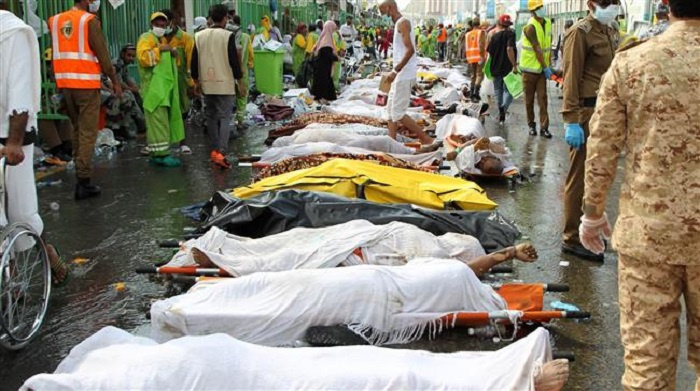Nine Reasons to Question Hajj Tragedy

The tragic death of hundreds of Iranian pilgrims in Saudi Arabia has triggered a tsunami of anti-Saudi sentiment throughout Iran, in light of the blatant self-serving response of Saudi officials, who have blamed the victims and tried to exonerate themselves of any blames whatsoever. Although the Saudi government has begun an official investigation and the final report on the causes of this tragedy has yet to be published, few Iranians vest much hope in it, given the adamant refusal of Saudis to let any other country partake in the investigation.
As expected, Tehran's call for an independent fact-finding committee consisting of representatives from all the nations where the victims came from, e.g., Pakistan, Nigeria, Egypt, Ghana, Iran, etc., has fallen on deaf ears and the Saudi rulers have dismissed Iranian leaders' criticism as completely unfounded. Iran has also called for international supervision of the Hajj ceremony, in order to prevent future such tragedies, which can be envisioned along the lines of the International Olympic Committee, which supervises the Olympic Games and is not considered an infringement on the host nation's sovereignty.
Meanwhile, based on the available empirical evidence surrounding this tragedy, there are numerous unanswered questions that await answers, one of which the facility with which it has been blamed on a "stampede" with pilgrims trampling on each other, as a result of which thousands were either killed or injured; the final tally has yet to be determined, although by now it is clear that the toll is in the thousands and not hundreds. There are still hundreds missing, including over 60 Iranian pilgrims, after so many days since the "accident," including a prominent Iranian diplomat, Ghazanfar Roknabadi, thus adding fuel to the furnace of Iranian suspicions about what really happened on that fateful day in Mina.
Although this tragedy has lent itself to a number of conspiracy theories and serious allegations of "mismanagement" and so on, it is important to distinguish facts from sheer rumors or insinuations and focus on direct and circumstantial evidence that guides objective scrutiny of the horrendous event -- that is blamed by the Saudis on the failure of some pilgrims to follow the written instructions given to them, the unplanned convergence of two groups of pilgrims moving in opposite directions, and the like. Saudi media and various Saudi representatives have consistently stated that this was a pure accident due to "overcrowding" and nothing more. Their explanation has been by and large adopted by the Western media, that has put it in the same category as the previous accidents claiming pilgrims' lives, such as the collapse of the giant crane just days before that claimed the lives of some 109 pilgrims including Iranians.
But, there are several empirical reasons to doubt the Saudi explanation and openly ponder the possibility of a "planned accident" that, in turn, raises the issue of an international criminal investigation of the potential culprits. Those reasons are as follows:
1. Evidence that the pilgrims on Street 204 in Mina were deliberately trapped with no ability to move forward or backward for hours.
2. Evidence that many pilgrims collapsed not as a result of any stampede but rather the sheer lack of water in the oppressive heat and human congestion, with the Saudis not taking a minimum step to rush to assist them, despite the presence of hundreds of their crowd control monitors along the route, the proximity of a fire station and a civil defense center, etc.
3. Evidence that the Saudis did not rush to assist the wounded either and the medical assistance did not reach the area until some 2 hours after the incident.
4. Evidence that the Saudis prevented the Iranian medical team from reaching and assisting the pilgrims.
5. Evidence that the standard operating procedure was ignored by the Saudis with respect to the supposed accidental convergence of two crowds and the obvious question is why? After all, the Saudi officials in the central command center closely watching the crowd’s movement with the help of over 4200 closed-circuit cameras (according to their own publications) should have taken immediate action to separate the crowd by implementing their contingency plans, yet somehow they did not and turned into passive observers of the unfolding tragedy.
6. Evidence that the Saudis seriously mistreated many of the wounded by throwing them into containers along with the dead, which may have contributed to the casualty figure.
7. Evidence that the Saudis engaged in a feeble cover-up by announcing that they had beheaded 28 people "responsible" for the tragedy, which both contradicts the official Saudi position that points the finger away from themselves and also adds to the suspicion of foul play with the Saudis trying to bury that initial information given to the Arab press.
8. Evidence that the "accidental convergence" of pilgrims moving in opposite directions was in fact a direct result of the Saudis moving the barricades and opening one-way traffic as clearly shown by the videos that have surfaced on the internet. This suggests more than a mere "negligence" and lends itself to the "planned accident" theory or hypothesis.
9. Evidence that some prominent Iranian pilgrims including Iran's former ambassador to Lebanon, considered a high-value target by the Israelis and Americans, may have been deliberately targeted, which explains the relatively high Iranian casualty figures as well as the hitherto unexplained mystery surrounding the lack of recovery of the Iranian diplomat’s body.

